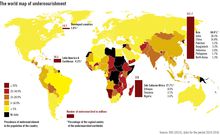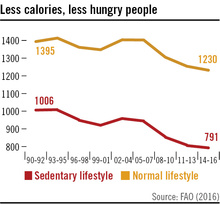Hunger in Times of Plenty
According to estimates from the Food and Agriculture Organisation, some 795 million people, almost one in nine, are currently undernourished, regularly not getting enough food in order to lead an active and healthy life. At the same time, agriculture is producing more food than ever before, both in total numbers as well as on a per capita basis, despite the fact that the world population is growing. If the harvest was used entirely and as effectively as possible as food, it could already feed 12 to 14 billion people.
The changeable history of the fight against hunger is as old as humanity whose populations had to adapt again and again to changing environmental conditions, epidemics and other adversities. For the first time since the beginnings of agriculture, humanity now has the means at its disposal to overcome world hunger.
At the 1996 World Food Summit in Rome, heads of state and government solemnly vowed to halve the number of people suffering from hunger to 425 million by 2015. The United Nations had already declared food an inalienable human right in 1948. However, today, people affected by hunger still do not have effective means of enforcing their right to adequate food and freedom from hunger. If they really wanted to, all governments worldwide could ensure that their citizens have enough to eat. A few countries would have to accept temporary foreign aid for this purpose. India, China, Pakistan, Bangladesh and Indonesia, however, where more than half of the world’s hungry live, do certainly not belong to these countries.
Global hunger statistics: flexible curves and goals
The global number of undernourished people published by the FAO each year refers to an average from the past three years and is based on complex assumptions and calculations, as well as national statistics of different quality and independence. Many of these assumptions have proved to be highly flexible. In 2009, the FAO warned that more than a billion people were suffering from hunger; in 2010 the number was 925 million. In 2011, the FAO revised its methodology. The number of undernourished then dropped to 868 million people, reaching 842 million in 2013 and 795 million in 2015. The goal of the 1996 World Food Summit of halving, between 1990 and 2015, the absolute number of people who suffer from hunger remains unattainable, whereas the Millennium Development Goal was narrowly missed. It was cunningly adapted only to halve, within the same period, the proportion of undernourished people, while the world population has grown by 2 billion people since 1990.
These new estimates now capture food losses but they also assume that people, on global average, are less physically active and somewhat smaller, and that distribution inequalities are less marked than previously thought. These and other assumptions changed, as if by magic, the curves depicting the number of hungry people, which now no longer tend upwards but downwards. The most important basis for the calculation of the number of undernourished is the daily energy requirement of a person. The FAO assumes a “sedentary lifestyle”, which is common in the case of office work. On global average, the minimum dietary energy requirement (MDER) for this lifestyle is 1844 kilocalories per day. If the calculations were based on a “normal lifestyle” - and in this case a minimum of 2023 kilocalories - the number of undernourished would zeal from 842 to 1297 billion people, or from 805 to 1210 billion people if the latest FAO estimates for the period 2012-2014 are considered. >>more
Facts & Figures
According to the Food and Agriculture Organisation, the estimated total number of undernourished people in the world reached 795 million people in the period 2014-2016, down from 820.7 million in 2010-12. The vast majority of hungry people - 779.9 million - live in developing regions.
64% of the world’s 795 million hungry live in Asia and the Pacific, followed by sub-Saharan Africa, home to 27.6% (220 million people) of the world’s undernourished population, and Latin America and the Caribbean (4.3% or 34.3 million people). The highest prevalence of undernourishment was found in sub-Saharan Africa, where 23.2% of the total population was undernourished.
Despite progress in reducing hunger worldwide, hunger levels in 52 of 117 countries in the 2015 Global Hunger Index remain “serious” (44 countries) or “alarming” (8 countries). The Central African Republic, Chad and Zambia had the highest hunger levels. For the Democratic Republic of Congo and other likely hunger hot spots, such as Eritrea, Somalia and South Sudan, reliable data is lacking. The index combines four indicators related to undernourishment, wasting, stunting and child mortality
Agriculture produces a third more calories than are needed to feed the entire world population. Per capita food availability rose from about 2,220 calories per person per day in the early 1960s to 2,891 calories in 2013-15. Developing countries recorded a leap from 1,850 calories per person per day to over 2,780 in the same period.
In 2014, world cereal production reached a record output of 2,558 million tonnes, up 10% from 2012. Despite this record-breaking harvest, only 43% was used to feed people, 36% was used for animal feed and the remainder for other uses such as seed, industrial non-food and waste.
In 2014, 159 million children worldwide - or almost one in four children - were stunted due to chronic malnutrition. An estimated 50 million children under the age of five suffered from wasting due to acute malnutrion, with almost 69% of these children living in Asia and 28% in Africa.
In 2015, approximately 5.9 million children worldwide - 16,164 children per day - died before reaching their fifth birthday. Pneumonia, diarrhoea and malaria make up about one third of all under five deaths. Globally, nearly half of all deaths among children under five are linked to undernutrition.
In April 2013, the FAO Food Price Index was at 217 points. This means that basic food stuffs were as expensive as during the food price crisis in 2008 and not far away from the historic peak of 240 points in February 2011.
In 2013, 17.5 million US households were what the Department of Agriculture calls "food insecure". That means that at some point last year, a lack of money made it difficult to buy food. Around 6.8 million households had "very low food security". In those homes, the food intake of some household members was reduced and normal eating patterns were disrupted due to limited resources.







